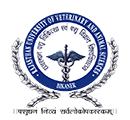Animal Feed Contamination :
Fink-Gremmels, Johanna
Animal Feed Contamination : Effects on livestock and food safety - Cambridge, UK ; Philadelphia : Woodhead Pub., 2012. - 672 p.
The production of animal feed increasingly relies on the global acquisition of feed material, increasing the risk of chemical and microbiological contaminants being transferred into food-producing animals. This book provides an overview of research into animal feed contaminants and their negative effects on both animal and human health
Introduction to animal feed contamination; Animal feeds, feeding practices and opportunities for feed contamination: an introduction. Part 1 Contamination by microorganisms and animal by-products: The ecology and control of bacterial pathogens in animal feed; Detection and enumeration of microbiological hazards in animal feed; Assessment of the microbiological risks in feedingstuffs for food-producing animals; Detection and identification of animal by-products in animal feed for the control of transmissible spongiform encephalopathies. Part 2 Contamination by persistent organic pollutants and toxic metals: Hazardous chemicals as animal feed contaminants and methods for their detection; Animal feed contamination by dioxins, polychlorinated biphenyls (PCBs) and brominated flame retardants; Animal feed contamination by toxic metals; Aquaculture feed contamination by persistent organic pollutants, heavy metals, additives and drug residues. Part 3 Natural toxins in animal feed: Mycotoxin contamination of animal feed; Detection and determination of natural toxins (mycotoxins and plant toxins) in feed; Prevention and control of animal feed contamination by mycotoxins and reduction of their adverse effects in livestock; Dietary exposure of livestock and humans to hepatotoxic natural products. Part 4 Veterinary medicinal products in feeds: Feed additives and veterinary drugs as contaminants in animal feed the problem of cross contamination during feed production; Antimicrobials in animal feed: Benefits and limitations; Alternatives to antimicrobial growth promoters (AGPs) in animal feed; Chemical risk assessment of animal feed. Part 5 Risks from emerging technologies: Safety of genetically modified (GM) crop ingredients in animal feed; Detection of genetically modified (GM) crops for control of animal feed integrity; Potential contamination issues arising from the use of biofuel and food industry by-products in animal feed; Nanoscale feed ingredients and animal and human health. Part 6 Feed safety and quality management: Animal feed sampling for contaminant analysis; Ensuring the safe supply of animal-derived ingredients for animal feed; Management of animal feed safety in the USA; The GMP+ Feed Safety Assurance (FSA) scheme.
9781845697259
Animal Nutrition
Animal Feed Contamination : Effects on livestock and food safety - Cambridge, UK ; Philadelphia : Woodhead Pub., 2012. - 672 p.
The production of animal feed increasingly relies on the global acquisition of feed material, increasing the risk of chemical and microbiological contaminants being transferred into food-producing animals. This book provides an overview of research into animal feed contaminants and their negative effects on both animal and human health
Introduction to animal feed contamination; Animal feeds, feeding practices and opportunities for feed contamination: an introduction. Part 1 Contamination by microorganisms and animal by-products: The ecology and control of bacterial pathogens in animal feed; Detection and enumeration of microbiological hazards in animal feed; Assessment of the microbiological risks in feedingstuffs for food-producing animals; Detection and identification of animal by-products in animal feed for the control of transmissible spongiform encephalopathies. Part 2 Contamination by persistent organic pollutants and toxic metals: Hazardous chemicals as animal feed contaminants and methods for their detection; Animal feed contamination by dioxins, polychlorinated biphenyls (PCBs) and brominated flame retardants; Animal feed contamination by toxic metals; Aquaculture feed contamination by persistent organic pollutants, heavy metals, additives and drug residues. Part 3 Natural toxins in animal feed: Mycotoxin contamination of animal feed; Detection and determination of natural toxins (mycotoxins and plant toxins) in feed; Prevention and control of animal feed contamination by mycotoxins and reduction of their adverse effects in livestock; Dietary exposure of livestock and humans to hepatotoxic natural products. Part 4 Veterinary medicinal products in feeds: Feed additives and veterinary drugs as contaminants in animal feed the problem of cross contamination during feed production; Antimicrobials in animal feed: Benefits and limitations; Alternatives to antimicrobial growth promoters (AGPs) in animal feed; Chemical risk assessment of animal feed. Part 5 Risks from emerging technologies: Safety of genetically modified (GM) crop ingredients in animal feed; Detection of genetically modified (GM) crops for control of animal feed integrity; Potential contamination issues arising from the use of biofuel and food industry by-products in animal feed; Nanoscale feed ingredients and animal and human health. Part 6 Feed safety and quality management: Animal feed sampling for contaminant analysis; Ensuring the safe supply of animal-derived ingredients for animal feed; Management of animal feed safety in the USA; The GMP+ Feed Safety Assurance (FSA) scheme.
9781845697259
Animal Nutrition


